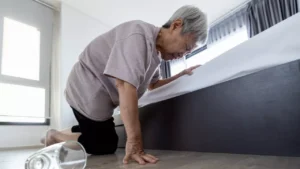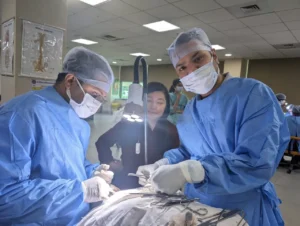Vertigo in the Elderly: Symptoms, Causes, Diagnosis, and Treatment
Vertigo, a sensation of spinning or dizziness, is a common complaint among older adults. While it can affect people of all ages, the elderly are particularly susceptible to vertigo and its associated symptoms. In this comprehensive article, we will explore the symptoms of vertigo in the elderly, its various causes, and the diagnostic and treatment options available.
Symptoms of Vertigo in the Elderly

Image Source: Canva
The primary symptom of vertigo is a feeling that you or your surroundings are spinning or moving, even when you are stationary[1. Older adults with vertigo may describe their symptoms as:
– Dizziness or lightheadedness
– Loss of balance or unsteadiness
– Nausea and vomiting
– Headache
– Ringing in the ears (tinnitus) or hearing loss
– Difficulty focusing or seeing clearly
These symptoms can range from mild to severe and may last anywhere from a few seconds to several hours or even days.
How Vertigo Symptoms Differ in the Elderly
While vertigo can cause similar symptoms in people of all ages, older adults may experience them differently. For example, elderly patients tend to report less rotatory vertigo (the classic spinning sensation) and more non-specific dizziness and instability compared to younger patients.
Additionally, older adults with vertigo may have a higher risk of falls due to age-related changes in balance, muscle strength, and reaction time. Falls can lead to serious injuries, such as fractures, head trauma, and even death, making vertigo a significant concern for the elderly population.
Causes of Vertigo in the Elderly

Image Source: Canva
Vertigo in older adults can be caused by various factors, ranging from inner ear disorders to neurological conditions. Some of the most common causes include:
Benign Paroxysmal Positional Vertigo (BPPV)
BPPV is the most common cause of vertigo in the elderly, accounting for approximately 50% of cases in those aged 70 or above. It occurs when tiny calcium crystals (otoconia) become dislodged from their normal location in the inner ear and migrate into the fluid-filled semicircular canals. This disrupts the normal flow of fluids and sends false signals to the brain, causing brief episodes of intense vertigo triggered by specific head movements.
Vestibular Neuritis and Labyrinthitis
Vestibular neuritis is an inflammation of the vestibular nerve, often caused by a viral infection. Labyrinthitis is a similar condition that also involves inflammation of the inner ear (labyrinth). Both conditions can cause sudden, severe vertigo lasting several days, often accompanied by nausea, vomiting, and balance problems.
Meniere’s Disease
Meniere’s disease is an inner ear disorder characterized by episodes of vertigo, fluctuating hearing loss, tinnitus, and a feeling of fullness in the ear. It is more prevalent in those above age 50. The exact cause is unknown, but it is thought to involve a buildup of fluid in the inner ear.
Age-Related Changes
As we age, various systems involved in maintaining balance, including the vestibular, visual, and proprioceptive systems, begin to decline. This natural deterioration, sometimes referred to as presbystasis or multisensory dizziness, can contribute to vertigo and instability in older adults.
Other Causes
Other potential causes of vertigo in the elderly include:
– Stroke or transient ischemic attack (TIA)
– Brain tumors
– Multiple sclerosis
– Migraine headaches
– Cervical spondylosis (arthritis of the neck)
– Medication side effects
Diagnosing Vertigo in the Elderly

Diagnosing vertigo in older adults can be challenging, as the symptoms may be vague, inconsistent, or attributed to other age-related conditions. A comprehensive evaluation by a healthcare professional, often an otolaryngologist (ENT) or neurologist, is essential for accurate diagnosis and treatment.
The diagnostic process typically involves:
- Thorough medical history, including a description of symptoms and any precipitating factors
- Physical examination, focusing on the ears, eyes, and neurological function
- Specialized tests, such as:
– Dix-Hallpike maneuver to assess for BPPV
– Vestibular function tests (e.g., electronystagmography, rotary chair test)
– Hearing tests (audiometry)
– Imaging studies (MRI or CT scan) to rule out central causes
Treating Vertigo in the Elderly

Image Source: Canva
Treatment for vertigo in older adults depends on the underlying cause and may involve a combination of approaches:
Vestibular Rehabilitation
Vestibular rehabilitation therapy (VRT) is a specialized form of physical therapy that helps the brain adapt to vestibular dysfunction. It involves exercises designed to improve balance, reduce dizziness, and promote central compensation. VRT is often recommended for older adults with persistent vertigo, as it can help reduce symptoms and improve quality of life.
Canalith Repositioning Maneuvers
For BPPV, canalith repositioning maneuvers, such as the Epley maneuver, can be highly effective. These maneuvers involve specific head and body movements that guide the displaced otoconia back into their proper location in the inner ear. A trained healthcare professional can perform these maneuvers in the office, and patients can also learn to do them at home.
Medications
While medications do not cure vertigo, they can help manage symptoms in the short term. Common medications used for vertigo include:
– Antihistamines (e.g., meclizine, dimenhydrinate)
– Benzodiazepines (e.g., diazepam, lorazepam)
– Anticholinergics (e.g., scopolamine)
However, these medications should be used cautiously in older adults, as they can cause side effects such as drowsiness, confusion, and increased risk of falls.
Lifestyle Modifications
In addition to medical treatments, lifestyle changes can help manage vertigo symptoms in the elderly:
– Staying hydrated
– Getting enough sleep
– Managing stress and anxiety
– Avoiding sudden head movements or positions that trigger vertigo
– Using assistive devices (e.g., cane, walker) to improve stability and reduce fall risk
Conclusion
Vertigo is a common and often debilitating condition among older adults, with various potential causes ranging from benign inner ear disorders to more serious neurological conditions. Recognizing the unique presentation of vertigo symptoms in the elderly and understanding the age-related factors that contribute to its development is crucial for accurate diagnosis and effective treatment.
By working closely with healthcare professionals and utilizing a combination of vestibular rehabilitation, repositioning maneuvers, medications, and lifestyle modifications, older adults with vertigo can find relief from their symptoms and improve their overall quality of life. It is essential for both patients and caregivers to be aware of the increased risk of falls associated with vertigo in the elderly and to take appropriate precautions to ensure safety and prevent injuries.
If you or a loved one is experiencing vertigo or dizziness, don’t hesitate to seek medical attention. With proper care and management, it is possible to successfully navigate the challenges of vertigo and maintain an active, fulfilling life in your golden years.
FAQ’s
What are the most common symptoms of vertigo in older adults?
– Common symptoms of vertigo in the elderly include dizziness, loss of balance, unsteadiness, nausea, vomiting, headache, tinnitus, hearing loss, and difficulty focusing or seeing clearly. Older adults may report less rotatory vertigo and more non-specific dizziness compared to younger individuals.
What are the main causes of vertigo in the elderly population?
– The most frequent causes of vertigo in older adults are audio-vestibular disorders (such as BPPV, vestibular neuritis, labyrinthitis, and Meniere’s disease), followed by cardiovascular and neurological diseases. Other causes include psychiatric conditions, ophthalmologic disorders, musculoskeletal issues, medication side effects, and metabolic-related diseases.
How does aging affect the vestibular system and contribute to vertigo?
– Age-related changes in the vestibular system, such as the loss of vestibular hair cells and neurons, can lead to decreased vestibular function and increased susceptibility to vertigo. Additionally, the age-related decline in visual, proprioceptive, and central integration of sensory inputs can contribute to dizziness and imbalance in older adults.
Why are older adults with vertigo at a higher risk of falls?
– Vertigo can cause unsteadiness and balance problems, which, combined with age-related changes in muscle strength, reaction time, and sensory input processing, can significantly increase the risk of falls in older adults. Falls can lead to serious injuries, reduced mobility, and loss of independence.
What is presbystasis, and how does it relate to vertigo in the elderly?
– Presbystasis, also known as presbyequilibrium or multisensory dizziness, refers to the age-related deterioration of balance function due to the progressive impairment of vestibular, visual, and proprioceptive systems, as well as the central integration of these sensory inputs. This condition can contribute to dizziness, vertigo, and instability in older adults.
How is vertigo diagnosed in older adults?
– Diagnosing vertigo in the elderly involves a comprehensive evaluation by a healthcare professional, including a thorough medical history, physical examination, and specialized tests such as the Dix-Hallpike maneuver, vestibular function tests, hearing tests, and imaging studies (MRI or CT scan) to rule out central causes.
What are the treatment options for vertigo in older adults?
– Treatment for vertigo in the elderly depends on the underlying cause and may include vestibular rehabilitation therapy, canalith repositioning maneuvers (like the Epley maneuver for BPPV), medications (used cautiously due to potential side effects and interactions), and lifestyle modifications (such as staying hydrated, managing stress, and avoiding triggers).
How effective is vestibular rehabilitation therapy in treating vertigo in older adults?
– Vestibular rehabilitation therapy (VRT) is highly effective in treating older adults with vestibular disorders. VRT helps promote central compensation, improve balance, and reduce dizziness through specific exercises designed to address the affected vestibular system. It is recommended for older adults with persistent vertigo to reduce symptoms and improve quality of life.
Can medications help manage vertigo symptoms in the elderly?
– While medications can help manage vertigo symptoms in the short term, they should be used cautiously in older adults due to potential side effects and interactions with other medications. Common medications used for vertigo include antihistamines, benzodiazepines, and anticholinergics. However, these medications may cause drowsiness, confusion, and increased risk of falls in the elderly.
What lifestyle changes can help older adults cope with vertigo?
– Lifestyle changes that can help older adults manage vertigo symptoms include staying hydrated, getting enough sleep, managing stress and anxiety, avoiding sudden head movements or positions that trigger vertigo, and using assistive devices (such as a cane or walker) to improve stability and reduce the risk of falls. Maintaining an active lifestyle and engaging in regular exercise, as tolerated, can also help improve balance and overall well-being.
